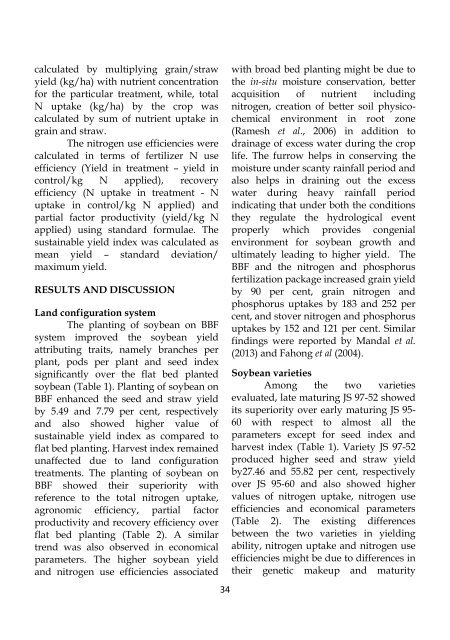SOYBEAN RESEARCH
Soybean-Research-14(2)-2016
Soybean-Research-14(2)-2016
You also want an ePaper? Increase the reach of your titles
YUMPU automatically turns print PDFs into web optimized ePapers that Google loves.
calculated by multiplying grain/straw<br />
yield (kg/ha) with nutrient concentration<br />
for the particular treatment, while, total<br />
N uptake (kg/ha) by the crop was<br />
calculated by sum of nutrient uptake in<br />
grain and straw.<br />
The nitrogen use efficiencies were<br />
calculated in terms of fertilizer N use<br />
efficiency (Yield in treatment – yield in<br />
control/kg N applied), recovery<br />
efficiency (N uptake in treatment - N<br />
uptake in control/kg N applied) and<br />
partial factor productivity (yield/kg N<br />
applied) using standard formulae. The<br />
sustainable yield index was calculated as<br />
mean yield – standard deviation/<br />
maximum yield.<br />
RESULTS AND DISCUSSION<br />
Land configuration system<br />
The planting of soybean on BBF<br />
system improved the soybean yield<br />
attributing traits, namely branches per<br />
plant, pods per plant and seed index<br />
significantly over the flat bed planted<br />
soybean (Table 1). Planting of soybean on<br />
BBF enhanced the seed and straw yield<br />
by 5.49 and 7.79 per cent, respectively<br />
and also showed higher value of<br />
sustainable yield index as compared to<br />
flat bed planting. Harvest index remained<br />
unaffected due to land configuration<br />
treatments. The planting of soybean on<br />
BBF showed their superiority with<br />
reference to the total nitrogen uptake,<br />
agronomic efficiency, partial factor<br />
productivity and recovery efficiency over<br />
flat bed planting (Table 2). A similar<br />
trend was also observed in economical<br />
parameters. The higher soybean yield<br />
and nitrogen use efficiencies associated<br />
34<br />
with broad bed planting might be due to<br />
the in-situ moisture conservation, better<br />
acquisition of nutrient including<br />
nitrogen, creation of better soil physicochemical<br />
environment in root zone<br />
(Ramesh et al., 2006) in addition to<br />
drainage of excess water during the crop<br />
life. The furrow helps in conserving the<br />
moisture under scanty rainfall period and<br />
also helps in draining out the excess<br />
water during heavy rainfall period<br />
indicating that under both the conditions<br />
they regulate the hydrological event<br />
properly which provides congenial<br />
environment for soybean growth and<br />
ultimately leading to higher yield. The<br />
BBF and the nitrogen and phosphorus<br />
fertilization package increased grain yield<br />
by 90 per cent, grain nitrogen and<br />
phosphorus uptakes by 183 and 252 per<br />
cent, and stover nitrogen and phosphorus<br />
uptakes by 152 and 121 per cent. Similar<br />
findings were reported by Mandal et al.<br />
(2013) and Fahong et al (2004).<br />
Soybean varieties<br />
Among the two varieties<br />
evaluated, late maturing JS 97-52 showed<br />
its superiority over early maturing JS 95-<br />
60 with respect to almost all the<br />
parameters except for seed index and<br />
harvest index (Table 1). Variety JS 97-52<br />
produced higher seed and straw yield<br />
by27.46 and 55.82 per cent, respectively<br />
over JS 95-60 and also showed higher<br />
values of nitrogen uptake, nitrogen use<br />
efficiencies and economical parameters<br />
(Table 2). The existing differences<br />
between the two varieties in yielding<br />
ability, nitrogen uptake and nitrogen use<br />
efficiencies might be due to differences in<br />
their genetic makeup and maturity


